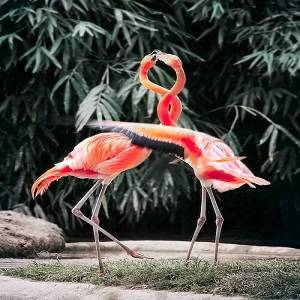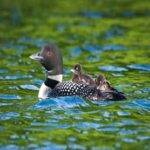Birds that mate for life, Monogamy is a mating system in which one male mates with one female and they form a pair bond. This bond may last for a single nesting, an entire breeding season, several successive breeding seasons, or even life. Monogamy is the predominant mating system in birds, with an estimated 90% of all bird species being monogamous.
There are many benefits to monogamy for birds. When both parents cooperate in raising their young, the chicks have a much better chance of survival. Monogamous pairs are also more likely to be able to defend their territory and resources from other birds.
There are a variety of ways that monogamy can evolve in birds. One common factor is that monogamy is more likely to evolve in species where the young require a lot of parental care. This is because it is in the best interests of both parents to work together to raise their young to adulthood.
Another factor that can lead to the evolution of monogamy is limited resources. For example, if there are only a few nesting sites available, it may be beneficial for a pair to bond together and defend their territory.
Birds that Mate for Life – List of 12 Species
Here are some examples of monogamous birds:
- Albatrosses
- Swans
- Geese
- Eagles
- Owls
- Parrots
- Robins
- Bluebirds
- Cardinals
- Chickadees
- Finches
- Sparrows
Monogamous birds exhibit a wide range of behaviors that help to maintain their pair bonds. These behaviors can include:
- Duetting (singing together)
- Allopreening (preening each other)
- Food sharing
- Nest building together
- Incubating eggs together
- Feeding chicks together
- Defending their territory together
Monogamous birds play an important role in the environment. They are responsible for pollinating plants, dispersing seeds, and controlling insect populations. Monogamy also helps to ensure that the genetic diversity of bird populations is maintained.
Monogamous birds are fascinating creatures that have evolved a variety of strategies to maintain their pair bonds. They play an important role in the environment and are a valuable part of our biodiversity.
The Science of Monogamy in Birds
The science of monogamy in birds is a complex and fascinating field of study. Monogamy is the mating system in which a single adult male and a single adult female mate. It is the most common mating system in birds, with over 90% of species being socially monogamous.
There are a number of factors that are thought to contribute to the evolution of monogamy in birds. One important factor is the need for biparental care. Many bird species have altricial young, which means that they are born helpless and require a lot of care from both parents.
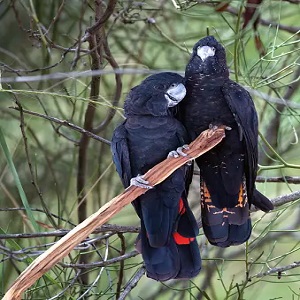
Another factor that is thought to promote monogamy in birds is the high cost of extra-pair reproduction. Extra-pair reproduction is when a female mates with a male other than her social partner. Additionally, extra-pair reproduction can make it difficult for females to ensure that their offspring are sired by high-quality males.
There are a number of ways in which birds maintain their monogamous bonds. One important factor is courtship. Courtship rituals can help to strengthen the pair bond and make it more difficult for other birds to interfere with the relationship. Another important factor is communication. Monogamous birds often communicate with each other through song, calls, and body language.
Finally, monogamous birds often engage in cooperative behaviors, such as building nests, incubating eggs, and feeding young. This cooperation helps to strengthen the pair bond and to ensure the success of the brood.
Here are some examples of bird species that are known to be socially monogamous:
- Swans
- Geese
- Albatrosses
- Eagles
- Hawks
- Owls
- Parrots
- Woodpeckers
- Finches
- Swallows
- Robins
- Wrens
7 Birds that Mate for Life: Finding True Love!
Seven bird species exemplify the beauty of monogamy in the avian world. From the graceful albatross to the loyal penguin, these creatures form lifelong bonds, sharing the ups and downs of life together. Their unwavering commitment and intricate courtship rituals make them heartwarming symbols of true love in nature.
1. Barn Owls
Barn owls nest in cavities, such as abandoned barns, trees, and cliffs. They lay between 4 and 7 eggs, which are incubated by the female for about 30 days. The young owls fledge from the nest after about 5 weeks.
Barn owls are important members of the ecosystem because they help to control populations of rodents. They are also relatively common and easy to observe, making them popular subjects for birdwatchers.
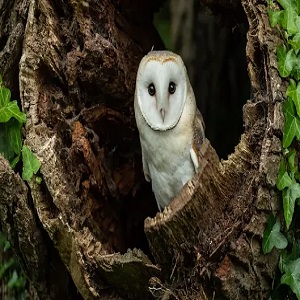
Barn owls are declining in some parts of their range due to habitat loss and poisoning from rodenticides. However, there are a number of conservation organizations working to protect these owls and their habitats.
- Barn owls are one of the most efficient predators in the world. They can catch up to 100 mice in a single night.
- Barn owls have a wingspan of up to 5 feet.
- Barn owls can rotate their heads almost 180 degrees. This allows them to scan their surroundings for prey without having to move their bodies.
- Barn owls have excellent night vision and hearing.
- Barn owls are social birds and often roost together in large groups.
- Barn owls are monogamous and mate for life.
2. Love Birds
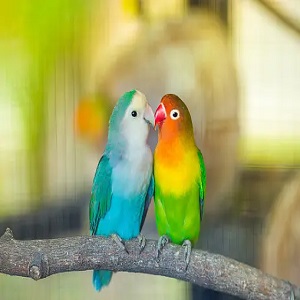
Lovebirds are small parrots known for their strong monogamous bonds and affectionate behavior. They are native to Africa, and there are nine different species. Lovebirds are popular pets because of their playful personalities and relatively easy care requirements.
In the wild, lovebirds live in flocks, but they pair up for life. They build nests together and raise their young cooperatively. Lovebirds are very social birds, and they enjoy spending time with their mates and other lovebirds.
Lovebirds are also very playful birds. They love to chew on toys and explore their surroundings. They are also intelligent birds, and they can be trained to do tricks.
If you are considering getting a lovebird as a pet, be sure to do your research to make sure you can provide them with the proper care. Lovebirds need a spacious cage, a variety of toys, and a balanced diet. They also need plenty of companionship, so it is important to have more than one lovebird if possible.
Lovebirds are beautiful and affectionate birds that can make wonderful companions. If you are looking for a loving and playful pet, a lovebird may be the perfect choice for you.
3. Black Vulture
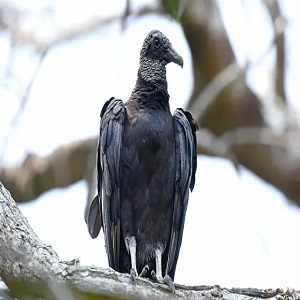
The black vulture (Coragyps Aratus) is a large, dark brown bird of prey found in the Americas. It is one of the most common vultures in the region, and is known for its distinctive bald head and neck. They play an important role in the ecosystem by helping to clean up dead animals and prevent the spread of disease.
Black vultures are large birds, with a wingspan of up to 6 feet. They have black plumage with a white patch on the underside of the wings. Their heads and necks are bare, and their beaks are hooked and sharp.
Black vultures are important members of the ecosystem, and play a vital role in cleaning up dead animals. They are also fascinating birds, and their unique appearance and behavior make them a popular subject for birdwatchers.
4. Atlantic Puffins
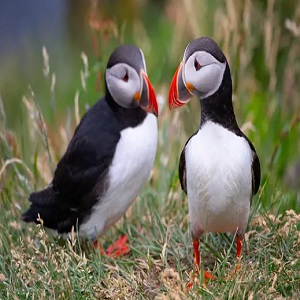
Atlantic puffins are known for their distinctive appearance, with a black and white body, bright orange and yellow bill, and colorful eye patches. They are also relatively large seabirds, with a wingspan of up to 60 centimeters.
Atlantic puffins are excellent swimmers and divers, and they spend most of their lives at sea. They feed on a variety of small fish, including sand eels, herring, and sprats.
Atlantic puffins breed on islands and sea cliffs in the North Atlantic Ocean. Females lay a single egg, and both parents help to incubate it and raise the chick.
5. Scarlet Macaw
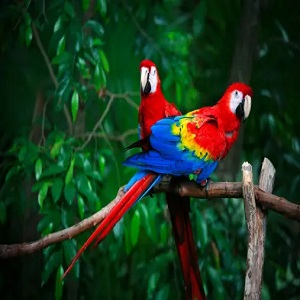
The scarlet macaw (Ara macao) is a large parrot with a striking appearance. It has bright red plumage, a creamy white face, and a long blue tail. Scarlet macaws are native to the rainforests of Central and South America, where they play an important role in dispersing seeds.
They are intelligent and playful birds, and they are known for their ability to mimic human speech. Scarlet macaws are also monogamous, and they mate for life.
Scarlet macaws are herbivores, and their diet consists mainly of fruits, nuts, and seeds. They use their powerful beaks to crack open hard nuts and seeds. Scarlet macaws also play an important role in the rainforest ecosystem by dispersing seeds. As they fly from tree to tree, they drop seeds from the fruits they have eaten. This helps to spread new plants throughout the rainforest.
Scarlet macaws are a beautiful and important species, but they are threatened by habitat loss and the illegal pet trade. It is important to protect these amazing birds and their rainforest home.
6. Bald Eagles
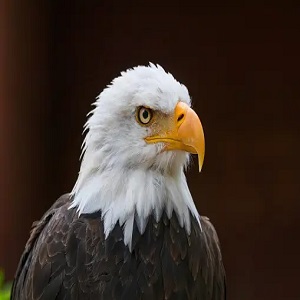
The bald eagle is the national bird of the United States and is one of the largest raptors in North America. It is a powerful and graceful bird with a dark brown body and wings, a white head and tail, and bright yellow feet and bill. Bald eagles have a wingspan of up to 7.5 feet and can weigh up to 15 pounds.
Bald eagles are found near large bodies of water, where they feed on fish, waterfowl, and other small animals. They are skilled hunters and can dive at speeds of up to 100 miles per hour to catch their prey.
Bald eagles were once on the brink of extinction due to habitat loss, hunting, and pesticide poisoning. However, thanks to conservation efforts, the bald eagle population has rebounded significantly in recent decades. Today, the bald eagle is a symbol of American strength and resilience.
7. Sandhill Cranes

Sandhill cranes are large, gray birds with long necks and legs. They are one of the tallest birds in North America, standing up to 4 feet tall. Sandhill cranes are migratory birds, and they travel long distances between their breeding and wintering grounds.
Sandhill cranes are social birds, and they often live in flocks of hundreds or even thousands of individuals. They are also very vocal birds, and their bugling calls can be heard from miles away.
Sandhill cranes are important members of the ecosystems they inhabit. They help to control populations of insects and other small animals, and they also disperse seeds.
Trumpeter Swans
Trumpeter swans are the largest waterfowl in North America and one of the largest flying birds in the world. They have a wingspan of up to 10 feet and can weigh up to 30 pounds. Trumpeter swans are known for their snow-white plumage, black legs and bill, and distinctive trumpeting call.
Trumpeter swans once nested throughout North America, but their populations were decimated by overhunting and habitat loss in the 19th and early 20th centuries. By the 1930s, there were fewer than 100 trumpeter swans remaining in the wild.
Thanks to conservation efforts, trumpeter swan populations have made a remarkable comeback. Today, there are over 45,000 trumpeter swans living in North America, and their range has expanded to include areas where they were once extirpated.
Trumpeter swans are social birds and often form large flocks. Trumpeter swans build their nests on islands or in marshy areas, and they lay 3-5 eggs per clutch. Both parents incubate the eggs and care for the young cygnets.
Here are some additional interesting facts about trumpeter swans:
- Trumpeter swans are known for their loud, trumpeting call, which can be heard for miles.
- Trumpeter swans are very long-lived birds and can live for up to 30 years in the wild.
- Trumpeter swans are excellent swimmers and can dive to depths of up to 20 feet.
- Trumpeter swans are very social birds and often form large flocks of hundreds or even thousands of individuals.
The Best Wood For Bird Houses: A Comprehensive Guide [2023]
Which Species of Birds Mate for Life?
Over 90% of bird species are monogamous, meaning that they have only one mate at a time. However, only a small percentage of these species mate for life. Birds that mate for life typically form strong bonds with their mates and work together to raise their young. This strategy can be advantageous in many ways, such as increasing the chances of offspring survival and reducing the need to compete with other birds for mates.
Some of the most common species of birds that mate for life include:
- White-tailed eagle
- Bald eagle
- Osprey
- Black vultures
- Mute swan
- Barn owl
Other species of birds that mate for life include penguins, parrots, owls, and some songbirds.
There are a number of reasons why birds mate for life. One reason is that it can increase the chances of offspring survival. Birds that mate for life are more likely to work together to build a nest, incubate eggs, and raise their young. This can help to ensure that their offspring are more likely to survive to adulthood.
Another reason why birds mate for life is that it can reduce the need to compete with other birds for mates. Birds that mate for life do not need to spend time and energy searching for a new mate each breeding season. This can free up their time and energy to focus on other important tasks, such as raising their young.
Mating for life can also be beneficial for birds because it allows them to develop strong pair bonds. These bonds can help to reduce stress and improve the overall well-being of the birds.
White-tailed eagle
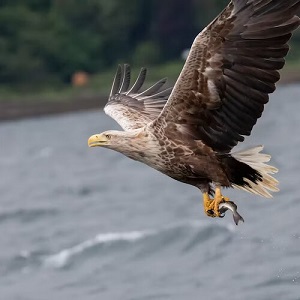
The White-tailed Eagle, also known as the Sea Eagle, is a majestic bird of prey native to Europe and parts of Asia. This impressive raptor boasts a wingspan of up to 8 feet (2.4 meters) and striking white plumage, accentuated by its prominent yellow beak and talons.
These eagles are known for their remarkable eyesight, which aids in hunting fish, waterfowl, and even carrion. Unlike many raptors, White-tailed Eagles often form monogamous pairs and maintain the same mate for life, engaging in intricate aerial displays as part of their courtship.
This behavior underscores their significance as a symbol of fidelity and strength in the natural world. Conservation efforts have been successful in some regions, allowing these magnificent birds to soar and inspire awe in the hearts of nature enthusiasts and conservationists alike.
Bald eagle
The bald eagle, revered as America’s national bird, is a magnificent symbol of monogamous devotion. These iconic raptors are known to form lifelong pair bonds. Each breeding season, they engage in breathtaking aerial courtship displays, reaffirming their commitment through dramatic swoops and spirals.
Once a pair has established their bond, they construct and maintain colossal nests together, adding to them year after year. This dedication extends to parenting, as both male and female eagles share the responsibilities of incubating eggs and raising their young, exemplifying the bald eagle’s status as a powerful symbol of loyalty and love in the natural world.
Osprey

The osprey, a remarkable bird of prey, is known for its strong commitment to monogamy. These magnificent raptors form pairs that endure throughout their lives, often returning to the same nesting sites year after year. Osprey couples engage in an intricate courtship dance, strengthening their bonds through synchronized aerial displays. Their partnership extends to raising their young, as both parents actively participate in hunting and providing for their offspring. The osprey’s devotion to their lifelong mate is a testament to the enduring power of love and partnership in the natural world.
Black vultures
Black vultures, often associated with scavenging and death, have a surprising side—they are dedicated to monogamy. These large, dark-plumaged birds form lifelong bonds with their partners. They engage in elaborate courtship rituals that include mutual preening and sky dances. Black vulture couples collaborate closely in raising their young, sharing the responsibilities of nest building, incubation, and feeding. Their monogamous relationships challenge stereotypes about these birds, highlighting their capacity for loyalty and devotion in the often harsh realm of nature.
Mute swan
The mute swan, with its graceful and elegant presence, is renowned for its devotion to monogamy. These majestic birds form lifelong partnerships that often begin with a captivating courtship display involving synchronized swimming and head bobbing. Once paired, mute swans work together to build and maintain their nests, and both partners actively participate in incubating and raising their cygnets. This commitment to their chosen mate and family exemplifies the enduring love and loyalty found in the avian world, making the mute swan a symbol of beauty and fidelity in nature.
Why Do Birds Eat Rocks? Do Birds Need To Eat Rocks? 10 Most Important Facts About Them
Barn owl
The barn owl, a nocturnal hunter of silent skies, displays a surprising commitment to monogamy. These birds form lifelong bonds with their mates, often selecting partners based on compatibility in hunting skills and territory. Barn owl couples engage in tender courtship rituals, exchanging food and affectionate behaviors. They share the responsibilities of raising their young, with both parents contributing to hunting for food and protecting the nest. The barn owl’s unwavering dedication to its mate highlights the depth of connection that can be found in even the most elusive corners of the avian world.
Conclusion
In the intricate tapestry of the natural world, monogamy emerges as a profound and diverse phenomenon. From the graceful courtship dances of swans to the collaborative parenting of wolves and beavers, the enduring bonds forged by animals reflect a wide spectrum of evolutionary strategies and social dynamics.
While monogamy may serve different purposes across species, it consistently underscores the significance of partnership, cooperation, and commitment in the animal kingdom. These examples of lifelong devotion remind us of the beauty and complexity of nature, offering glimpses into the profound connections that transcend the boundaries of our own species. Monogamy in the animal kingdom serves as a testament to the enduring power of love and cooperation in the world around us.
FAQs
What does it mean for birds to “mate for life”?
This question explores the concept of monogamy in birds and what it entails for a bird species to form lifelong pair bonds.
Are monogamous birds truly loyal to a single partner throughout their lives?
This question delves into the fidelity and commitment of birds in monogamous relationships, addressing whether they stay loyal or if there are exceptions.
What are some famous examples of birds that mate for life?
This question seeks to highlight specific bird species known for their monogamous behavior and provide readers with iconic examples.
What are the reasons behind birds choosing to mate for life?
This question explores the evolutionary, ecological, and behavioral factors that drive certain bird species to engage in lifelong partnerships.
How do monogamous birds navigate challenges and life events together?
This question investigates how monogamous bird pairs work together in various aspects of their lives, such as nesting, raising offspring, and facing adversity as a team.
Reference:-
